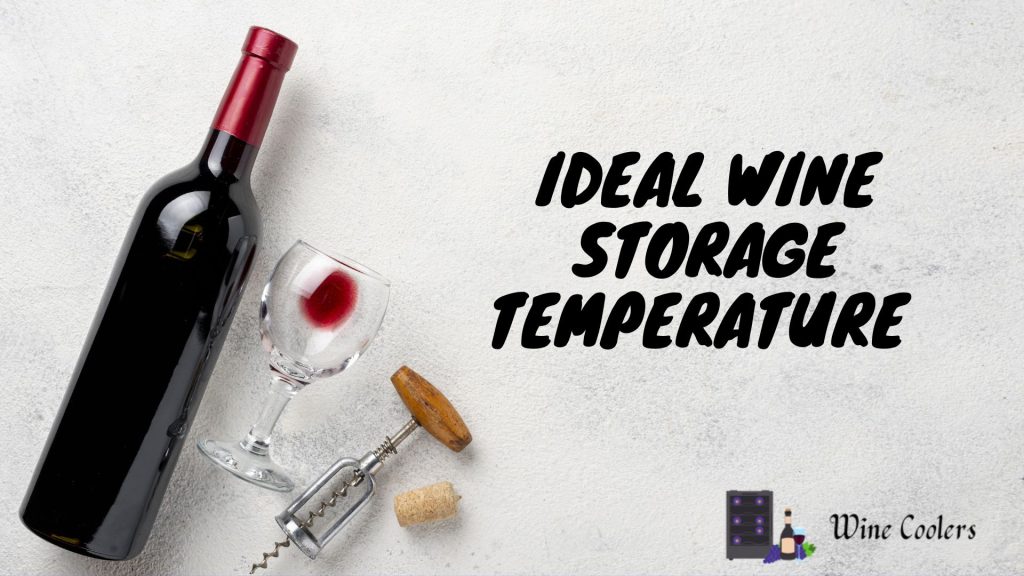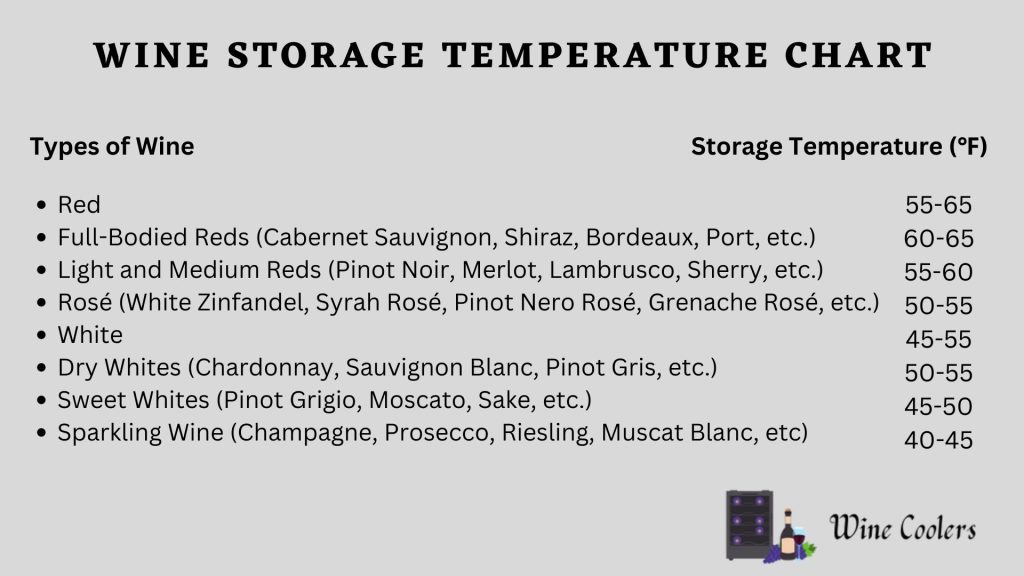
To unwind from a stressful week or to toast a joyous event, nothing beats cracking open a bottle of your go-to vino. Whether you favor red, white, or rosé, you want to make the most of your wine when you consume it.
The temperature at which you keep the wine is one of the most crucial factors in producing a quality bottle of wine. Proper wine storage is essential, but knowing what to do may be challenging given the wide variety of wines available.
Also Read: Best Wine Coolers: The Ultimate Guide
That’s why we went ahead and compiled all the data you’ll ever need to know about wine storage temps in one easy-to-reference document.
Here, you’ll learn everything you need to know about wine storage, from the best temperature range for different types to how important it is to keep your wine in the same place over time. We’ve included a handy temperature chart to help you keep track of everything, as well as a short FAQ section to answer any pressing questions you may have about how to store your wine. To that end, let’s not waste any more time and go in.
What’s the Importance of Wine Storage Temperature?
Wine has to be kept at a specific temperature for a number of reasons. Keeping your wine at the ideal temperature can extend its shelf life, protect it from being too hot or too cold (both of which may severely damage the wine), and keep it tasting its best.
Wines benefit from being kept at temperatures ranging from the cool of the fridge to slightly lower than room temperature. Keeping your wine at the ideal temperature can protect its quality, since even little fluctuations in temperature can have far-reaching consequences.
Also Read: Best Free-Standing Wine Coolers Reviews
Storing your wine at the incorrect temperature might have a few undesirable results. Wine that has been stored at either too low or too high of a temperature increases the danger of spoilage, as well as of bacterial growth, loss of flavor and aroma, and the development of harsh tannins.
Allowing wine to get too cold and freeze causes it to expand, which can harm the wine itself, push out the cork (allowing oxygen to get to the wine), or even break the bottle.
You can avoid having to deal with these problems by storing your wine at the ideal temperature, and you can extend the period of time that your wine tastes great by ensuring that the temperature is stable and that it is stored in the optimal atmosphere. However, not all wines require the same circumstances, and it’s crucial to learn the ideal temperature for storing each type of wine.
At What Temperature Should I Store My Wine?
As was previously noted, different varieties of wine require different temperatures when being stored. In any case, you may get a fair notion of what temperature to store your wine at by following a few simple principles for wine storage.
Lighter wines, such as whites and rosés, should be stored in a cooler area than heavier wines, much as red wines should be served at room temperature and whites and rosés should be served cold.
Also Read: Best Cheap Wine Coolers for Every Budget
The lighter the wine, the cooler it should be served. The ideal storage temperature decreases as the wine’s perceived lightness increases, therefore darker reds can be kept at warmer temperatures than rosés, whites, and sparkling wines. You may find the optimal storage temps for many wines here.
Red Wine Temperature
The depth of color in red wines is mostly a function of their age and intensity, leading to a number of distinct classifications. The term “full-bodied” is used to describe the strongest, darkest wines because of the robust tastes and greater alcohol level that they possess.
Medium-bodied red wines are a pleasant middle ground between full-bodied reds and the even lighter light reds. Both have lower alcohol level and more delicate tastes than their full-bodied counterparts. Despite the fact that they are all red wines, these bottles require distinct storage conditions due to their vast differences in appearance and flavor.
Also Read: Best Portable Wine Coolers
Full Red Wine Temperature
The greatest temperatures, only a few degrees below room temperature, are suitable for storing full-bodied reds. Common full-bodied reds like Cabernet Sauvignon, Malbec, and Burgundy benefit from being kept at a cool, steady temperature of roughly 63 degrees Fahrenheit (17 degrees Celsius).
Reds with more body and color, like Bordeaux and Shiraz, benefit from somewhat warmer storage conditions, at roughly 64 degrees Fahrenheit (18 degrees Celsius). The greatest recommended temperature for storing wine is 66°F (19°C), which is ideal for the deepest, richest red wines (such as Port and Madeira).
Light and Medium Red Wine Temperature
In most cases, the temperature difference between storing light and medium red wines is only a few degrees. The ideal storage temperature for lighter reds is between 55 and 60 degrees Fahrenheit. The ideal cellar temperature for a Merlot or Sherry, both of which fall into the medium red wine category, is between 57 and 60 degrees Fahrenheit (14 and 16 degrees Celsius). Lambrusco and Pinot Noir, two of the lightest red wines, should be served at temperatures as low as 56 degrees Fahrenheit (13 degrees Celsius).
Also Read: Best Compact Wine Coolers
Rose Wine Temperature
You may enjoy the best of both worlds with a rosé: the robust, mature tastes of red wine and the delicate delicacy of white wine. Just like they’re best served somewhere in the middle of the temperature extremes at which red and white wines are typically stored, so too is their optimal storage temperature.
The same rule that applies to red wines also applies to rosé: the darker the rosé, the cooler it has to be stored. This is typically between 50 and 55 degrees Fahrenheit (10 and 13 degrees Celsius) for different shades of rosé.
There isn’t much of a difference here, and unless we’re talking about long-term storage, you don’t need to worry over a few degrees if you’re not sure where your rosé sits on the spectrum. Some rosés, like Pinot Nero Rosé and Grenache Rosé, are lighter and should be held at temperatures as low as 51°F (11°C), while others, like Syrah Rosé and White Zinfandel, are darker and should be kept at temperatures as high as 55°F (13°C).
White Wine Temperature
White wines, like red wines, are divided up into many types. White wines, on the other hand, are evaluated not by their hue but rather their acidity and sweetness. The residual sugar in dry white wines has been reduced by more than 99% during fermentation, giving them a smoother texture and a more refined taste.
The residual sugar in sweet white wines is higher, making them fruitier and, as the name implies, sweeter. When compared to red wines and rosés, white wines are best kept at a colder temperature, namely between 45°F (7°C) to 55°F (12°C).
Also Read: Best Quiet Wine Coolers for Peaceful Storage
Dry Wine Temperature
While sweet white wines can be stored at room temperature, dry whites require refrigeration. Chardonnay, Sauvignon Blanc, and Pinot Gris are three examples of popular dry white wines. Chardonnay is at the upper end of the spectrum and requires storage at roughly 53°F (11°C), while Sauvignon Blanc and Pinot Gris are kept colder, around 47°F (8°C).
Sweet Wine Temperature
Typically, they are stored at a temperature between 45 and 50 degrees Fahrenheit (7 and 10 degrees Celsius), considerably lower than that recommended for dry white wines. Wines like Pinot Grigio are at their finest at 45°F (7°C), while Moscato and Sake are at their best around 42–43°F (5–6°C) on the cooler end of this spectrum.
Sparkling Wine Temperature
There is a strict temperature range between 40 and 45 degrees Fahrenheit (5-7 degrees Celsius) where sparkling wines should be kept. Although white wines are the norm for sparkling wines, rosé sparkling wines are available and are best served at slightly warmer temperatures. Muscat and Prosecco are two of the most often consumed sparkling wines; they should be maintained at a cool 42 degrees Fahrenheit (6 degrees Celsius), whereas Riesling and, most famously, Champagne should be kept at a warmer 44 degrees Fahrenheit (7 degrees Celsius).
Also Read: Best Wine Coolers With Locks
Wine Storage Temperature Chart

FAQ on Wine Storage Temperature
There’s a reason why wine cellars are used for aging wine: these conditions are ideal for preserving the wine’s flavor and aroma. However, most individuals don’t have a wine cellar lying around, so you’ll have to locate another place with the right conditions. Wines that benefit from a warmer environment (often medium-bodied to full-bodied reds) should be kept in a cold, dark place, such as a wine cellar.
White wines, sweet wines, and sparkling wines are more difficult to work with since they must be refrigerated to a colder temperature. Short-term storage, up to a few days, is good in a refrigerator.
Under-the-stairs storage, a garage, or any other climate-controlled space can serve as a suitable substitute for a wine cellar. Two things to keep in mind while storing wine in the garage are the effects of vibrations and strong odors, which may be mitigated by keeping the bottles properly insulated.
If you’re ready to spend a little more money, you may also get a wine fridge, which has zones for storing wine at different temperatures.
To a large extent, this is determined by the wine’s variety. While it’s true that storing wine in a cool location is ideal for some varieties, it can also be detrimental for others.
Even wines that are meant to be chilled can be negatively affected by extreme cold. This is because wine expands as it freezes, perhaps forcing the cork out and exposing the wine to air, or even breaking the bottle.
Keep the wine in a temperature-controlled area to avoid this problem and enjoy it at its peak quality for as long as possible. If you plan on preserving your wine for an extended period of time, you may increase its shelf life by storing it at slightly lower than suggested temperatures.
Don’t worry if you don’t have the storage capacity to keep your wine organized by kind. Keep your wines at a comfortable temperature; a few degrees won’t do much harm and you won’t risk ruining a bottle.
Although improper wine storage temperatures can have negative effects on the wine, the situation is not so hazardous that short-term storage of diverse wines at substantially comparable storage temperatures would result in poor wine.
Therefore, you should look for wines with only a couple of degrees of variance in optimal storage temperatures rather than keeping wines with a wide temperature range. You’ll need to locate separate areas to store wines that require vastly different temperatures to preserve their quality, such as Champagne (which has to be stored at 43°F) and Cabernet Sauvignon (which needs to be stored at 63°F). If you’re not sure what temperature to serve your wine at, a safe bet is 55 degrees Fahrenheit.
Conclusion
With this newfound knowledge, you may confidently choose the ideal conditions in which to keep your wine. If you want every drop of wine in your bottle to taste its best, you need to store it properly. Wine is at its optimal flavor profile between 57 and 59 degrees Fahrenheit.
This advice can help you remember the ideal serving temperature for your wine, even if the ideal temperature will vary from wine to wine.
